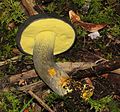
The Boletaceae are a family of mushroom-forming fungi, primarily characterised by small pores on the spore-bearing hymenial surface, instead of gills as are found in most agarics. Nearly as widely distributed as the agarics, the family is renowned for hosting some prime edible species highly sought after by mushroom hunters worldwide, such as the cep or king bolete . A number of rare or threatened species are also present in the family, that have become the focus of increasing conservation concerns. As a whole, the typical members of the family are commonly known as boletes.

Xerocomus is a genus of poroid fungi related to Boletus. Many mycologists did not originally recognize the distinction between the two genera and placed Xerocomus taxa in genus Boletus. However, several molecular phylogenetic studies have demonstrated that Xerocomus is a heterogeneous genus of polyphyletic origin, which has resulted in further division of Xerocomus into Xerocomellus and Hemileccinum. The members of the genus Xerocomellus are more closely related to Boletus than true Xerocomus is, which is relatively distantly related to Boletus and more closely related to Phylloporus. Other former Xerocomus species have since been moved to Aureoboletus, Imleria, Hortiboletus and Rheubarbariboletus.
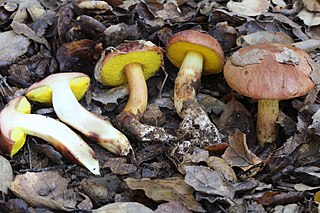
Aureoboletus is a genus of bolete fungi in the family Boletaceae. It was circumscribed by Czech mycologist Zdeněk Pouzar in 1957. A taxonomic monograph was published in 2010 by Wolfgang Klofac.

Pulveroboletus is a genus of fungi in the family Boletaceae. The genus has a cosmopolitan distribution and contains 41 species.
Mackintoshia is a fungal genus in the family Boletaceae. It was originally placed in Cortinariaceae. The genus is monotypic, containing the single truffle-like species Mackintoshia persica, found in Zimbabwe. This fungus, eaten by both the common duiker and the Karanga people, is little known outside the Midlands Province of Zimbabwe. Mackintoshia was circumscribed by Giovanni Pacioni and Cathy Sharp in 2000. The genus name honors British-Rhodesian farmer Robbie Mackintosh, who collected and documented some early specimens. The specific epithet persica is Latin for peach, referring to its odor.
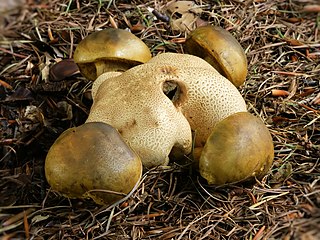
Pseudoboletus is a genus of fungi in the family Boletaceae. The genus contains two species found in north temperate areas that grow in a parasitic association with species of Scleroderma and Pisolithus.
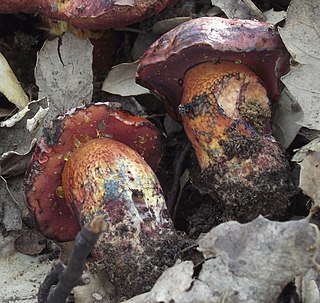
Exsudoporus permagnificus is a species of bolete fungus in the family Boletaceae, native to Southern Europe and Western Asia. Described as new to science in 1981, the fungus was originally placed in genus Boletus. Following molecular studies outlining a new phylogenetic framework for Boletaceae, the fungus was transferred to the newly erected genus Exsudoporus in 2014, to which it is the type species. Nevertheless, Wu and colleagues (2016) were reluctant to accept the newly proposed genus due to a lack of sufficient sequences and regarded it a synonym of Butyriboletus. Following studies reinstated the status of Exsudoporus as a monophyletic genus sister to Butyriboletus, following additional collections and extended phylogenetic and morphological analyses.

Retiboletus vinaceipes is a species of bolete fungus in the family Boletaceae. Found in the Dominican Republic, it was described as new to science in 2007.

Boletus curtisii is a species of fungus in the family Boletaceae. It produces small- to medium-sized fruit bodies (mushrooms) with a convex cap up to 9.5 cm (3.7 in) wide atop a slender stem that can reach a length of 12 cm (4.7 in). In young specimens, the cap and stem are bright golden yellow, although the color dulls to brownish when old. Both the stem and cap are slimy or sticky when young. On the underside of the cap are small circular to angular pores. The mushroom is edible, but not appealing. It is found in eastern and southern North America, where it grows in a mycorrhizal association with hardwood and conifer trees. Once classified as a species of Pulveroboletus, the yellow color of B. curtisii is a result of pigments chemically distinct from those responsible for the yellow coloring of Pulveroboletus.
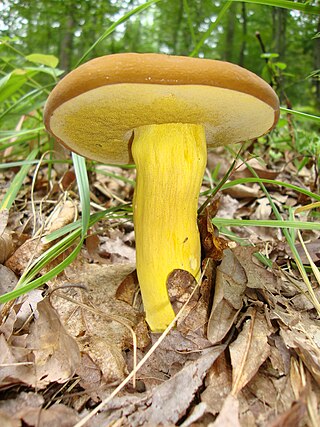
Boletus auripes, commonly known as the butter-foot bolete, is a species of bolete fungus in the family Boletaceae. First described from New York in 1898, the fungus is found in eastern Asia, Central America, and eastern North America from Canada to Florida. It is a mycorrhizal species and typically grows in association with oak and beech trees.

Aureoboletus auriflammeus, commonly known as the flaming gold bolete, is a species of bolete fungus in the family Boletaceae. Described as new to science in 1872, it is found in eastern North America, where it grows in a mycorrhizal association with oaks. The caps of the fruit bodies are golden orange, with a yellow pore surface on the underside, and a reticulated (network-like) stem. The edibility of the mushroom is not known.

Xerocomellus is a genus of fungi in the family Boletaceae. The genus, as it was described in 2008, contained 12 species. However X. rubellus and X. engelii were transferred to the new genus Hortiboletus and X. armeniacus was transferred to the new genus Rheubarbariboletus in 2015. Molecular analysis supports the distinction of Xerocomellus species from Boletus and Xerocomus, within which these species were formerly contained. Xerocomellus in fact is only distantly related to Xerocomus and is most closely related to Tylopilus, Boletus sensu stricto, Porphyrellus, Strobilomyces, and Xanthoconium.

Lanmaoa pseudosensibilis is a fungus of the family Boletaceae native to the United States. First described officially in 1971 by mycologists Alexander H. Smith and Harry Delbert Thiers, it was transferred to the newly circumscribed genus Lanmaoa in 2015.

Retiboletus ornatipes, commonly known as the ornate-stalked bolete or goldstalk, is a species of bolete fungus in the family Boletaceae. Originally named Boletus ornatipes by American mycologist Charles Horton Peck in 1878, it was transferred to Retiboletus in 2002.

Retiboletus griseus, commonly known as the gray bolete, is a species of bolete fungus in the family Boletaceae. The species was first described scientifically in 1878 by American botanist Charles Christopher Frost. It was transferred to Retiboletus in 2002.
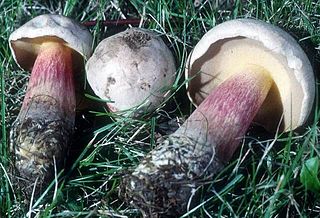
Caloboletus inedulis is a bolete fungus of the family Boletaceae that is native to North America. Until 2014, it was known as Boletus inedulis. Recent changes in the phylogenetic framework of the Boletaceae prompted the transfer of this species, along with several other related boletes, including Caloboletus calopus, to the genus Caloboletus. The species is inedible.
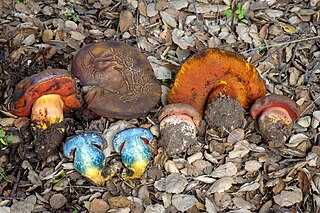
Suillellus is a genus of bolete fungi in the family Boletaceae. It was originally described by William Alphonso Murrill in 1909 with Suillellus luridus as the type species. The genus was later merged with Boletus, but was eventually resurrected in 2014, after molecular phylogenetics research demonstrated that Suillellus species comprised a different lineage than Boletus.

Rubroboletus is a genus of bolete fungi in the family Boletaceae. It was circumscribed by Chinese mycologists in 2014 with Rubroboletus sinicus as the type species. Species are characterized by having a reddish cap surface, yellow tubes on the underside of the cap, and an orange-red to blood-red pore surface. Pinkish to red spots (reticula) are present on the stipe surface, and a bluish color change occurs when the bolete flesh is injured. Rubroboletus mushrooms have an olive-brown spore print, and produce smooth spores. Eight species were included in the original circumscription ; five were added in 2015, and another in 2017.
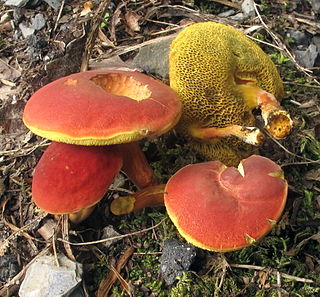
Hortiboletus is a genus of fungi in the family Boletaceae. It was circumscribed in 2015 by Giampaolo Simonini, Alfredo Vizzini, and Matteo Gelardi. The erection of Hortiboletus follows recent molecular studies that outlined a new phylogenetic framework for the Boletaceae. Hortiboletus is derived from the Latin word hortus "garden", referring to a typical habitat of the type species, Hortiboletus rubellus. The bolete H. bubalinus, originally described as a Boletus and later placed in Xerocomus, was transferred to the genus by Bálint Dima. In 2015, Alona Yu. Biketova transferred Boletus campestris and Boletus engelii to Hortiboletus.

Exsudoporus is a genus of fungi in the family Boletaceae. It was circumscribed in 2014 by Alfredo Vizzini and colleagues, following a number of molecular studies that outlined a new phylogenetic framework for Boletaceae and revealed the genus Boletus in its traditional circumscription to be polyphyletic. However, due to lack of sufficient sequences, Wu and colleagues (2016) were reluctant to accept the newly proposed genus and considered it a synonym of Butyriboletus. Following additional phylogenetic sequencing and morphological analyses, Exsudoporus was clearly resolved as a monophyletic, homogenous and independent genus that is sister to Butyriboletus.

